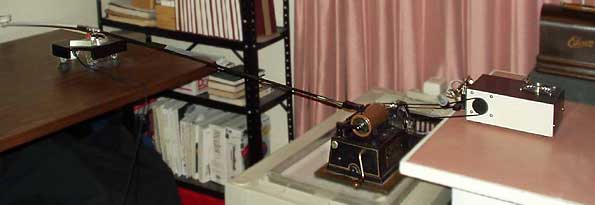
Version: April 25, 2004
 |
|
Version: April 25, 2004 |

|
Glenn Sage in Portland, Oregon has a site called Tinfoil. He sells CDs with recorded music from older cylinders, and also offers free CDs to anyone willing to lend him brown wax cylinders for transfer. The purpose of his work is, as he puts it, primarily "to grow interest and familiarity with our great heritage of early recorded sounds". This is the reason why he offers to preserve the sound on early brown wax cylinder recordings (1888-1903). To this day he has transferred more than 1000 cylinders. His unusual player is not built as one device, but comes in three parts, which have to be set up and aligned every time the player is moved. The base of his player is an Edison phonograph, a sturdy machine with the mandrel supported at both ends. The narrow-end support is called an end-gate. It is driven by a computer-controlled stepping motor built into a box, a Shinano SST 55 with 200 steps per revolution. The motor drives the mandrel via a belt, and the tension of the belt is controlled by a pulley that simply rests on it with its weight. Speed is set from the computer via software written by Glenn himself, and the range is somewhat wider than 1 - 200 rpm. Calibration is done with an infrared optical tachometer. The tone arm is well over a meter long. The two thirds on the stylus side of the pivot are made of carbon tubing, and the one third toward the counterweight is made of nylon tubing. As can be seen in the picture above, it flexes quite a lot. This flexing absorbs imperfections in the cylinders. The tonearm with cartridge but no counterweight weighs in at 34 grams, the counterweight alone weighs 70 grams and it is fitted with a tray for small adjustment weights. In spite of its size, Glenn emphasizes the portability of the system. It can be used with other phonographs than his own, and he gladly packs his tone arm for "road trips" to transfer collections too large to be shipped. In 2002, this player replaced Glenn's old setup with a similarly long arm and a smaller motor. Christer Hamp, 2004
| |
|
|
Close-up of the pivot with its rubber feet, from the picture above.
|
The Shinano SST 55 stepping motor in its box |
| |

| Visit Glenn Sage (many audio files) at: | |
